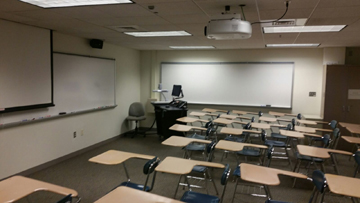
SVC Podcast – Show Notes – Show 170-2
In this edition of the SVC Podcast, Contributing Editor Bennett Liles resumes his talk with Doug Smith, director of learning spaces and audio/visual technologies at Illinois State University regarding the classroom AV technology upgrades implemented there. Doug comments on the BYOD movement and RF coordination on the campus along with assisting some technologically challenged faculty members and AV budget planning.
For Part 1
Links of interest:
- The Office of Academic Technologies at Illinois State University
- The VP-773A ProScale Presentation Switcher/Scaler
- AMX Control Systems in Education
Download Podcast Here:
https://s3.amazonaws.com/nb-svc/public/public/170-2_Illinois_State_Unive…
This is the SVC Podcast from Sound & Video Contractor Magazine with Doug Smith of Illinois State University. Show notes and equipment links for the podcast are on the web site of Sound & Video Contractor Magazine at svconline.com.
Illinois State University wanted to modernize its classroom AV systems and reduce trouble calls at the same time. Doug Smith, director of learning spaces and audio/visual technologies decided to team with Kramer Electronics and install switchers to ease the faculty connection with AV sources. He’s back to finish his story on the broad upgrade that was accomplished there. That’s all coming right up on the SVC Podcast.
Doug, nice having you back for Part 2 on the SVC Podcast from Illinois State University. You’ve got classroom AV upgrades including Kramer Electronics switchers and you have to keep over 300 classrooms up and running every day. One of the more recent challenges to that is the Bring-Your-Own-Device movement. Is there a wide assortment of wireless connectivity going on there?
Oh, absolutely and our telecom folks have done a fantastic job of doing wireless upgrades on our campus. Over the last three years there was a big push to refresh the entire system and make sure that coverage was all over campus and it’s been fantastic. I’m not aware of any spaces on campus where I can’t find a wireless signal of quality so I’m very pleased with that piece of the support. [Timestamp: 1:36]
And I’m figuring that you’re also using RF wireless microphones here and there. Do you ever have any frequency coordination issues with those in that dense a classroom environment?
We have not. We manage all of the wireless microphones for the campus so having the ability to track and manage all the channels that are in use or to be used helps that a lot. That doesn’t mean that we haven’t seen a rogue device that comes into a room and interferes. I can’t control for that. But as a whole we’ve not experienced any major issues with RF interruptions. [Timestamp: 2:13]
That’s remarkable. A university campus would appear to be ground-zero for all the new wireless devices. I’m sure the addition of the Kramer gear makes it easier for faculty to select the source devices they need but there are other manufacturers that have combined to make that whole AV scenario work well.
Kramer is at the core of all of our classrooms. The switcher platform is Kramer throughout our campus and they’ve been a fantastic company to work with for a number of reasons. It’s been a great decision to do that. But there are other components that make our success work and I just want to be on the record. We also are an AMX control system throughout and we have Epson projectors throughout. And all three of those companies have been producing products that not only work very, very well and reliably, but they’re also cost effective. We’ve got AMX controllers that are now pushing 13 years old. We loaded new code on them this last weekend, they’re still humming right along. It’s because of all three of those companies, the quality of the products, the quality of the support that we’ve gotten from them, and the cost at which we’re able to buy those products that we’ve been able to make this major push to 320-some classrooms. [Timestamp: 3:29]
And when people bring their devices on campus, who do you find using the newer network technology, primarily students or faculty?
It’s both, to be sure, though clearly our students are walking in – I forget the number, but our telecom folks indicated that based on what they’re seeing on all the wireless access points that in those spaces where they can measure how many people are in an area something like three-and-a-half connected devices per person, which is a challenge for them. But I think every year we see more and more use especially as we bring young faculty on. They’re anxious to use the newer tools. [Timestamp: 4:07]
How do you deal with faculty members who may be hesitant to push any buttons or use any of the AV gear?
We offer to meet with them. We’ve got materials available for them to look up and to see how to use the interface, for example. Every college also has their local tech support folks who do things within the college and we work with them closely to make sure that they can go in and support the faculty as well. But absolutely if somebody wants to meet with us and go over the system we’re more than happy to do that and make sure they can walk in on day one and be successful. [Timestamp: 4:38]
And not have to be learning it in front of the class.
I joke that we, all of us in some kind of an IT role create an auto magic. And anybody who’s not in our areas really can’t appreciate the amount of work that goes on behind the scenes to make a simple button push do a whole bunch of different things. But faculty as a whole really do appreciate the fact that they’re hired to teach not deal with technology and to the extent that we’re all successful in allowing them to simply walk in and do the thing that they were hired to do then we’ve made it. We’ve done our job well. [Timestamp: 5:16]
And since you do a lot of your work behind the scenes, what does your team do between semesters when these rooms are empty and you have a chance to get in anywhere and do anything?
Well, there’s always maintenance. As long as we have projectors on the ceiling there will always be lamps and filters that need to be maintained. There will always be calibrations to be done. We’re forever collecting data so any kind of upgrades. We do relish those days when there aren’t any classes so we can get in and continue ongoing maintenance. But as a whole, the time at which there are no classes – at least on this campus – is dwindling rapidly and it makes that quite a challenge. [Timestamp: 5:51]
And I’m sure you find especially with a few of the older rooms where the room was just not basically designed for AV use and there are wall switches in the wrong place or the lighting is not quite right for projection.
Yeah. On our campus that’s a bit of a challenge. Lighting controls are still wall switches for the most part. In our large lecture halls we do have the ability to integrate those into our touch panels. But beyond that, that’s mostly a facilities piece and so now it’s a coordination between our office as AV folks and the facilities’ planners to take a second look at where is the location of the switches, the HVAC and the other things that have an impact on the environment. [Timestamp: 6:34]
We have a few new HVAC systems on our campus and they shake the ceilings a lot more that the old ones did and that of course shakes the projector images, too. How do you manage to do budget planning for AV to deal with aging equipment and the life cycle of the AV gear?
Well, we are adequately funded – mostly adequately funded, depending on how you count the numbers, to continue down and maintain the 320-some classrooms that we currently have. Saying that, though, we are putting equipment out on very long refresh periods. The only device that we refresh regularly is the computer. We do keep those on a four-year cycle. Projectors, we are monitoring their usage and we refresh those based on the service hours of the unit. We also collect data about the brightness, contrast ratio, and those kind of things. So they’re on a much longer life span as well. Of course once in a while devices just plain fail and then they get replaced. But we’re keeping stuff a lot longer than we normally used to, but some of that is the fact that we have the luxury that we’ve got good projectors that are plenty bright enough, that were sized correctly for the rooms and that they just keep working as long as we keep the lamps fed. The switchers, they just keep working. We’ve got amplifiers out in the classrooms now that are pushing 14 years old. They continue to hum along. So the idea that we need to go out and arbitrarily say every six years replace X-amount of gear, we just don’t do that. [Timestamp: 8:10]
Well, this has been great. It’s always interesting for me to hear a story about AV in the classroom environment. My hat’s off to you and your team for accomplishing what you do in a very challenging situation. Doug Smith, director of learning spaces and audio/visual technologies at Illinois State University. Thanks for telling us about it, Doug.
Great. Thanks. Thanks for having me.
Thanks to Doug Smith of Illinois State University for joining us on the podcast. Show notes and equipment links are on the website of Sound & Video Contractor Magazine at svconline.com. Be back with us next week for the SVC Podcast.










